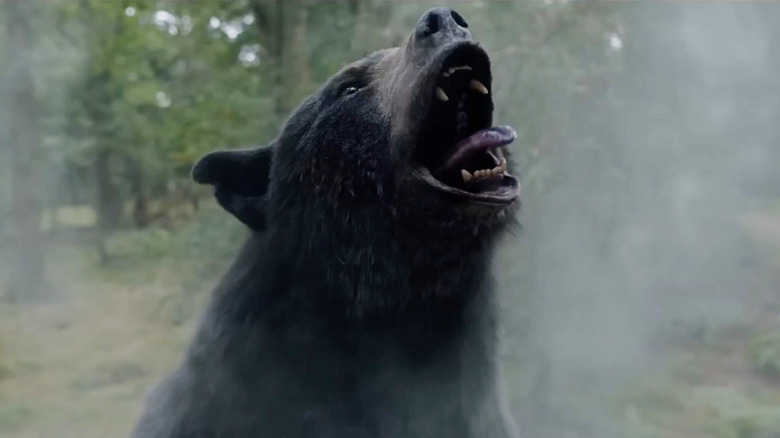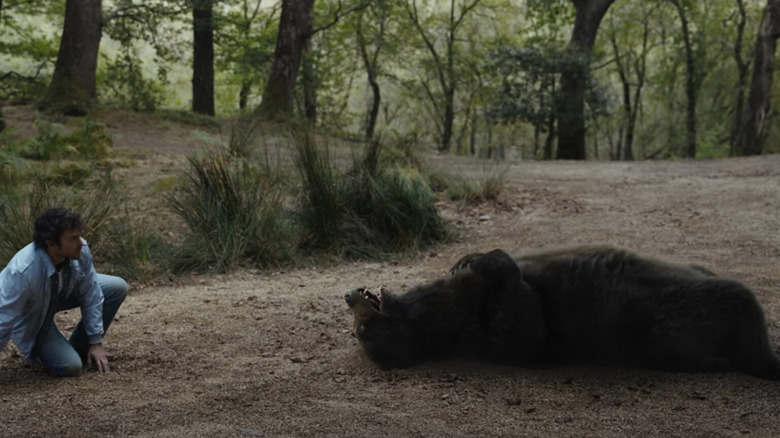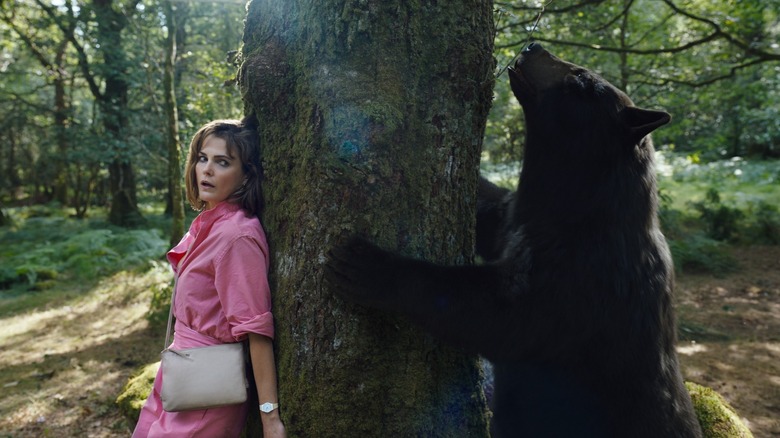Cocaine Bear Ending Explained: The Bear Did Cocaine
Elizabeth Banks' new film "Cocaine Bear" was indeed inspired by true events. In 1985, a drug smuggler dropped a duffel bag containing $15 million worth of cocaine from a plane into the woods below. There, it was found by a 175-pound black bear, who proceeded to consume the cocaine. Unlike in Banks' movie, where the bear eats the cocaine and goes on a killing spree, the real-life bear wasn't known to have killed anyone. The bear simply died of a drug overdose. Because it was so well-preserved, the bear was taxidermied and subsequently passed around among various owners, not all of whom knew its cause of death. Waylon Jennings owned the Cocaine Bear at one point. These days, one can visit the Kentucky Fun Mall in Lexington, KY, and visit the bear's taxidermied body. Its current owners, Whit Hiler and Griffin VanMeter, have cleverly named their prize "Pablo Escobear."
Banks' film is refreshingly uncomplicated. A bear finds cocaine in the woods, eats it, and immediately goes feral, killing anyone it can, and constantly fiending for another hit. It also seems to have developed a supernatural ability to sense where its next fix might be, and chows down on any poor soul who happens to be dusted with snow. By the end of the film, drug dealers have been dispatched, fathers are reunited with their kids, and the Cocaine Bear and her two cubs — oh yes, mama bear did feed the coke to her cubs — have been transformed by drugs into rampaging, murderous creatures.
Typically, black bears are fairly docile. Banks even quotes the utmost authority on bears, Wikipedia, in a chyron at the film's head.
Man vs. nature
In terms of structure, "Cocaine Bear" is little different from any number of animal-attack movies that have been appearing in theaters since at least the 1950s. In said genre, an animal is exposed to radiation, consumes a dangerous chemical, or escapes from a primordial holding cell to wreak havoc on the modern-day human population. This was even the premise of the original 1954 "Godzilla" film, wherein radiation created, more or less, a gigantic radioactive walking whale gorilla.
When looked at as a whole, animal attack movies tend to be a genre about environmentalism. In all said films, humankind unwisely encroaches too far into the natural world, and the animals strike back. Sometimes the animal is an outsize rampaging creature, as in Nathan H. Juran's 1957 film "The Deadly Mantis." Sometimes they are mere animals who are divinely punishing littering yuppies, as in Colin Eggleston's 1978 film "Long Weekend." Most typically, though, nature is merely enacting a form of cosmic revenge against humankind. If humans are foolhardy enough to spread pollution and radiation, the Earth will happily provide comeuppance.
"Cocaine Bear" sees a collection of dastardly humans — many of the film's characters are scumbags and criminals — getting mauled as a result of their own product. The titular bear becomes a monster as a direct result of widespread cocaine dealing. According to the DEA, cocaine use skyrocketed in the United States in the 1980s, and Congress passed the Anti Drug Abuse Act in 1986, making drug penalties harsher.
But "Cocaine Bear" is not a scare film or a "message picture" about the dangers of cocaine. If anything, it's a whimsical, gory satire of Reagan-era drug policies.
Cocaine Bear vs. Nancy Reagan
Elizabeth Banks is careful to begin her film with some of the anti-drug media that was prevalent throughout the 1980s. She includes a clip of a crack-disparaging PSA featuring Pee Wee Herman, the infamous Partnership for a Drug-Free America "This is your brain on drugs" campaign, and, most notably, a closeup of Nancy Reagan, the First Lady during the events of "Cocaine Bear." In September 1986, Reagan spearheaded her infamous "Just Say No" campaign, which encouraged any youths offered drugs to merely refuse. The campaign was mocked immediately, with many critics pointing out that Reagan failed to consider the nuances and complexities of drug addiction. A 2014 study in Scientific American eventually revealed how ineffectual such campaigns typically are in stemming drug consumption.
Overall, the U.S. government has been incredibly clumsy in its handling of drug crimes, often increasing punitive measures for drug-users, rather than allocating rehabilitation services and health care. As Prohibition proved, the banning of a controlled substance does little to decrease its ubiquity. The notorious War on Drugs is a controversial and repeatedly bungled effort to do everything but actually provide public aid to people dealing with addiction.
Elizabeth Banks has, then, made an anti-anti-drug film. In construct, the cocaine bear is an instrument of vengeance employed against drug dealers. In effect, however, Banks' film is whimsical, absurd, gory, and fun. The bear is an admirable hero, following its own bliss and reducing any obstructor into piles of viscera. "Cocaine Bear" is meant to be cheered and hooted at. It's best enjoyed with a crowd.
What better way to satirize the War on Drugs than with a violent grindhouse movie?


